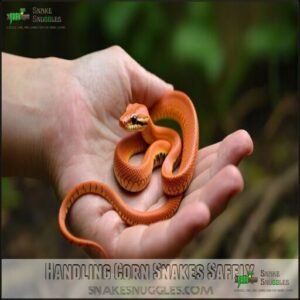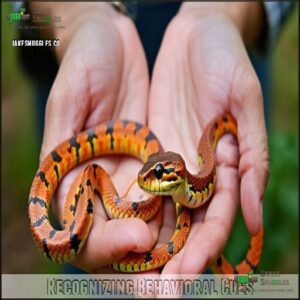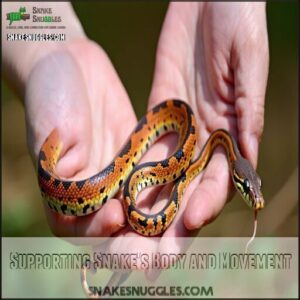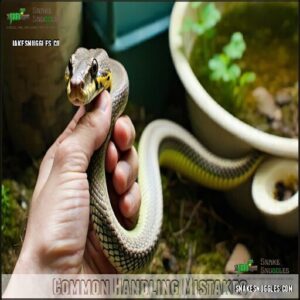This site is supported by our readers. We may earn a commission, at no cost to you, if you purchase through links.
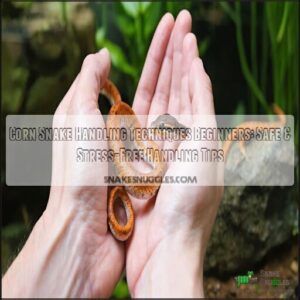
Always approach from the side rather than above (they’re prey animals, after all). Support your snake’s body with both hands, never grabbing the middle or restraining the head.
You’ll need to wait about a week after bringing your snake home before first handling, then limit sessions to 5-10 minutes initially. Don’t handle during shedding or within 48 hours after feeding.
If your snake seems tense or makes quick movements, simply return it to its enclosure. Proper corn snake handling techniques build trust—your scaly friend can actually recognize your scent over time.
Table Of Contents
- Key Takeaways
- Handling Corn Snakes Safely
- Choosing The Right Snake
- Setting Up Corn Snake Enclosures
- Feeding Corn Snakes Properly
- Recognizing Behavioral Cues
- Handling Techniques for Beginners
- Building Trust and Bonding
- Common Handling Mistakes
- Frequently Asked Questions (FAQs)
- How long does it take to handle a corn snake?
- How do you handle a corn snake?
- How do you pick up a corn snake?
- Are corn snakes easy to handle?
- Can a corn snake handle a No-No?
- How do you stop a corn snake from being scared?
- How to handle a corn snake for the first time?
- How do I start handling my snake?
- Do corn snakes like to be stroked?
- Can corn snakes recognize their owners?
- Conclusion
Key Takeaways
- Wait a week after bringing your corn snake home before handling, and keep sessions short initially—5-10 minutes works best.
- Always approach calmly from the side, support its body with both hands, and avoid sudden movements to prevent stress.
- Don’t handle your snake during shedding or within 48 hours after feeding to ensure its comfort and health.
- Watch for signs of stress like rapid movements or tight coiling, and return it to its enclosure if it seems tense.
Handling Corn Snakes Safely
Handling your corn snake safely is all about patience, gentleness, and knowing when to give it space.
Patience, gentleness, and giving space are the keys to safe and stress-free corn snake handling.
By understanding its needs and respecting its cues, you’ll build trust and keep both of you stress-free.
Waiting Period Before Handling
Give your new corn snake time to adjust—don’t rush it like meeting a shy roommate.
The acclimation period lets it settle into its new environment and reduces defensiveness.
Wait 5-7 days before handling, and only start after it’s eaten.
Gradual handling during this adjustment phase establishes trust. Remember, patience now leads to smoother corn snake handling for beginners later, and it’s essential for a good adjustment.
Handling Frequency and Duration
Start with 5-minute handling sessions and aim for two to three times a week.
Gradually increase the handling duration as your corn snake becomes more comfortable, but avoid going beyond 15 minutes at a time.
Consistent handling builds trust, but don’t overdo it—watch for signs of stress like reduced appetite.
A solid handling schedule keeps everyone happy.
Avoiding Handling During Shedding
Snake shedding changes everything.
Watch for shedding signs like cloudy eyes and dull skin. Handling during shedding isn’t ideal—your snake might show defensive behavior due to impaired vision.
Wait until the shedding process is complete before resuming handling.
Boost humidity, as it helps with smooth sheds. Respecting shedding considerations keeps your corn snake handling stress-free and guarantees a happier, healthier snake.
Preventing Regurgitation
Avoid handling your snake too soon after meals—it’s like shaking a soda can; things might get messy.
Wait at least 48 hours after feeding before handling to allow proper digestion.
Keep the temperature gradient in the tank consistent, and make certain prey size isn’t too large.
Stress reduction is key to avoiding regurgitation risks during corn snake handling.
Improper feeding can also cause issues, so match prey size and type, as oversized prey matters.
Choosing The Right Snake
Picking the right corn snake sets the stage for safe and enjoyable handling, so it’s worth doing a bit of homework.
Focus on finding one from a reputable breeder, checking its health, and choosing a morph that fits your budget.
Sourcing From Reputable Breeders
Reputable breeders guarantee healthy, ethically bred corn snakes, so choose wisely.
Look for breeders with strong reviews and health guarantees—essential for beginner snake handling. Morph availability varies, so ask about options.
Verify ethical breeding practices and safe shipping methods to avoid stress on your snake. A dependable breeder simplifies corn snake care and enhances your safe snake handling experience.
- **Check reviews and breeder reputation.
- **Ask about health guarantees.
- **Inquire about morph availability.
- **Verify ethical breeding and practices.
- **Verify safe shipping methods.
Checking Snake Health and Age
A corn snake’s health hinges on smooth skin condition, clear eye clarity, regular eating habits, and an alert activity level.
Always prioritize a breeder’s reputation to guarantee robust snake health.
Younger snakes grow faster, so tracking their hatch date helps monitor development.
Careful observation and these handling techniques guarantee safer, stress-free snake handling while fostering good corn snake care practices.
Considering Morph Costs and Budget
Think about your budget when choosing a corn snake. Morph popularity, color genetics, and rarity can impact the price.
Here’s how to decide:
- Common Morphs: Affordable and easy to find, great for beginners.
- Rare Morphs: Eye-catching but pricier, consider them an investment.
- Future Trends: Research growing interest in unique colors for potential resale value.
Setting Up Corn Snake Enclosures
Creating the perfect enclosure for your corn snake isn’t as tricky as it sounds, but getting the basics right is vital for their health and happiness.
From tank size to temperature gradients, setting up a safe environment guarantees your snake feels right at home.
Tank Size and Substrate Options
Once you’ve picked the perfect snake, it’s time to create a cozy home.
Enclosure size matters—juveniles fit in a smaller terrarium, while adults need at least 40 gallons.
Substrate options like aspen shavings support burrowing, and hiding spots help them feel secure.
Add climbing needs for enrichment.
Proper ventilation is essential for a healthy corn snake enclosure.
Regular enclosure cleaning keeps their setup healthy.
Creating Temperature Gradients
Your corn snake care starts with proper temperature requirements.
In your terrarium setup, create a gradient using these tips:
- Set a basking spot temp around 85°F using a heat source choice like a bulb or mat.
- Cool side temp should hover in the low 70s for balance.
- Use thermostat control and gradient monitoring tools to guarantee comfort.
Many owners find a reptile thermostat is essential for maintaining safe temperatures and overall comfort.
Maintaining Humidity Levels
Humidity monitoring isn’t just reptile care basics—it’s a game-changer for snake comfort.
Keep levels between 40-60% to avoid shedding problems. Check substrate moisture weekly and mist as needed.
But don’t overdo it! Proper humidity requires a reliable digital hygrometer.
Corn snake care includes proper enclosure ventilation to prevent mold buildup.
Remember, a well-balanced habitat keeps your snake happy and you stress-free.
Feeding Corn Snakes Properly
Feeding your corn snake properly guarantees its health and keeps it happy. Stick to a schedule, use frozen rodents, and occasionally dust prey with calcium for balanced nutrition.
Feeding Frequency Based on Age
In terms of feeding, match frequency to your snake’s age.
Hatchlings eat every 5-7 days, juveniles every 7-10 days, adults every 14-21 days, and seniors may need less.
Stick to these intervals to avoid obesity while ensuring proper nutrition.
Consider appropriate rodent sizes for each stage.
This practice supports overall corn snake care and makes snake handling easier with a happy, healthy pet, promoting proper nutrition.
Using Frozen Rodents and Variety
Frozen rodents are safer than live prey for corn snake feeding—no risk of injury for your pet.
Match the rodent size to your snake’s widest body part.
Thaw snake prey in warm water, never microwaves.
Mixing up the menu with Reptilinks or occasional quail eggs adds nutritional variety.
Stick to your feeding schedule for happy, healthy snakes!
Dusting Prey With Calcium Supplements
While feeding frozen rodents provides nutrition, dusting them with calcium supplements adds an extra boost for occasional snake care.
For safe supplementation, consider the following guidelines:
- Use calcium powder sparingly, avoiding over-supplementation risks.
- Dust prey lightly with a pinch right before feeding.
- Stick to a low supplement frequency to prevent imbalances.
- Consider alternative supplements if unsure—vet advice always helps!
Recognizing Behavioral Cues
Watching your corn snake’s behavior is key to understanding its mood and comfort level.
Learn to spot signs like tongue flicking or defensive postures, so you know when your snake’s calm or needs a break.
Tongue Flicking and Curiosity
When your corn snake flicks its tongue, it’s like scanning the air for scents—a natural “what’s going on here?” moment.
Flicking frequency can indicate curiosity and environmental awareness.
This exploration behavior shows the snake’s comfort level.
Think of it as their way of asking questions about their world, which is an incredible part of snake communication during handling!
Defensive Postures and Stress Indicators
How can you spot when your corn snake is stressed or defensive? Pay attention to its body language and actions:
- A coiled neck resembling an "S" and head retraction shows threatened defensive behaviors.
- Rapid, erratic motions or tail rattling signal fear or stress.
- Muscle tension and reduced activity often indicate discomfort.
- Biting signs suggest misinterpreted behavior or unease during handling.
The key signs to look out for include a combination of these behaviors, which can indicate that the snake is experiencing discomfort.
Watching for Signs of Overhandling
Overhandling your corn snake can lead to reduced appetite, lethargic behavior, or excessive hiding—like the reptile version of giving you the silent treatment.
Watch for erratic movements or muscle tension during handling sessions. If your snake seems stressed, ease up.
Simple snake handling tips like shorter sessions and gentle handling techniques are key to balancing trust and effective corn snake care.
Handling Techniques for Beginners
Handling your corn snake confidently starts with simple, gentle techniques that help both you and your snake feel secure.
By supporting its body and moving slowly, you’ll encourage trust while keeping the experience stress-free.
Approaching and Picking Up Snakes
Before reaching for your corn snake, always signal your presence with a gentle tap using a paper towel roll. This calm approach prevents startling your scaly friend.
- Enter from the side, not above, to avoid triggering defensive instincts
- Use hook guidance for nervous snakes before attempting hands-on contact
- Apply a gentle scoop technique, sliding your hand under their mid-section
- Maintain a secure grip without squeezing
- Allow the snake to feel supported before lifting completely
Supporting Snake’s Body and Movement
Proper support forms the foundation of confident corn snake handling techniques.
Always use both hands to provide a secure hold – one near the middle and another offering gentle guidance toward the tail.
Never dangle your snake or support just the head or tail.
Let your corn snake explore while maintaining body support and movement control, preventing any accidental drops that could stress or injure your slithery friend, and always prioritize their safety with gentle guidance.
Using Slow and Deliberate Movements
Now that you’ve mastered supporting your corn snake, let’s focus on movement quality. When handling your snake, slow and deliberate movements are your secret weapon for building confidence and preventing startled reactions.
- Move like you’re in slow motion to minimize stress
- Keep your breathing calm and steady
- Telegraph your intentions before changing hand positions
Quick or jerky movements can make your snake feel unsafe. Smooth, gentle handling creates a sense of security your scaly friend will appreciate, which is key to a safe environment.
Building Trust and Bonding
You’ll build a strong bond with your corn snake through consistent, gentle interactions that show you’re a friend, not a threat.
Just like making friends at a new school, earning your snake’s trust takes patience and respect for their comfort zone.
But the reward of a relaxed, curious companion is worth every minute, and with consistent effort, you can achieve this.
Starting With Short Handling Sessions
After the initial acclimation period, start with just 5-minute handling sessions.
You’ll want to keep these early interactions brief to prevent stress on your corn snake. Watch for signs that your snake remains comfortable—regular tongue flicks indicate curiosity rather than fear.
These short sessions build trust gradually while avoiding overhandling. Aim for consistency rather than length; twice weekly is ideal for beginners learning proper corn snake handling techniques, focusing on proper techniques and avoiding overhandling.
Gradually Increasing Handling Time
As you work with your corn snake over time, gradually build up from those initial 5-minute sessions.
Once your snake shows comfort through relaxed movements and regular tongue flicking, extend handling time by 2-3 minutes each week. Most corn snakes adapt to 15-minute sessions within a month.
Remember to support snake bodies fully during each handling session.
Pay attention to temperament changes – if your snake seems stressed, simply reduce the handling time temporarily, focusing on relaxed movements and regular tongue flicking to ensure a comfortable experience.
Avoiding Sudden Movements and Restraint
As your handling sessions lengthen, focus on smooth movements. Corn snakes startle easily when jerked around or held too tightly.
For stress-free corn snake handling techniques:
- Keep your hands relaxed—tense grips make snakes nervous
- Move at a slow, predictable pace when repositioning your hands
- Allow natural exploration without restraining head or tail
- Use gentle guidance rather than forceful control
Patient handling builds trust and prevents defensive strikes.
Common Handling Mistakes
You’ll save yourself and your scaly friend a lot of stress by avoiding these common handling mistakes that even seasoned keepers make from time to time.
From picking up your corn snake during shedding to misreading those subtle stress signals, knowing what not to do is just as important as mastering the proper techniques.
Handling During Shedding or Feeding
Many first-time snake owners make the critical mistake of handling during shedding or feeding times.
This disruption can stress your corn snake and lead to serious health issues.
| Period | Signs | Action |
|---|---|---|
| Shedding | Cloudy blue eyes | Avoid handling completely |
| Post-feeding | Within 48 hours | No handling to prevent regurgitation |
| Defensive posture | S-shaped neck, hissing | Back off immediately |
Wait 48 hours after meals and resume handling only after shedding completes for a happy, healthy corn snake.
Ignoring Signs of Stress or Overhandling
While handling limitations during feeding and shedding are essential, reading your snake’s body language is equally important.
You’ll miss warning signs if you’re not paying attention. Watch for defensive behavior like erratic movements, hiding excessively, appetite loss, or lethargy signs.
Corn snake stress often manifests through tight coiling or rapid breathing.
Overhandling is real—your scaly friend needs downtime to feel secure and maintain healthy stress levels.
Failing to Provide Proper Support and Care
Beginners often commit the cardinal sin of inadequate support when handling their corn snakes.
You’ll stress your snake if you dangle it by its tail or grab it behind the head. Always provide gentle support beneath its entire body, preventing thermal burns by keeping it away from heat sources.
Improper feeding techniques and neglecting health checks can lead to dehydration risks and unnecessary corn snake stress.
Providing them with secure hiding spots is also essential for reducing stress and ensuring their overall well-being is maintained through proper care.
Frequently Asked Questions (FAQs)
How long does it take to handle a corn snake?
Good things come to those who wait, so give your corn snake 2 weeks to settle after coming home.
Then, start with 5-minute sessions, gradually increasing to 10-15 minutes as it gets comfortable.
How do you handle a corn snake?
Approach your corn snake calmly from the side, scoop it up gently, supporting its body and tail.
Keep movements slow and steady, avoid sudden grabs, and let the snake explore your hands naturally.
Stay patient!
How do you pick up a corn snake?
Slide your hand under the snake from the side, supporting its belly while avoiding sudden movements.
Use your other hand near the tail for balance.
Stay calm and let the snake explore naturally.
Are corn snakes easy to handle?
Don’t worry if you’re new—corn snakes are easy to handle with patience and gentle techniques.
Their calm nature and manageable size make them great for bonding, as long as you move slowly and respect their boundaries.
Can a corn snake handle a No-No?
Corn snakes can’t handle a “No-No” because they don’t understand instructions or discipline.
Instead, focus on proper handling techniques and observing their body language to guarantee they feel safe and comfortable during interactions, using this approach to ensure a positive experience with your corn snakes.
How do you stop a corn snake from being scared?
To calm a scared corn snake, move slowly, support its body fully, and avoid sudden motions.
Handle it regularly, but not excessively—build trust gradually.
Speak softly—yes, snakes notice vibrations.
Patience truly is key!
How to handle a corn snake for the first time?
Approach gently from the side, supporting the snake’s body with both hands.
Keep movements slow, and avoid sudden grabs.
Start with 5-10 minute sessions, letting the snake explore while you stay calm and patient.
How do I start handling my snake?
Start by letting your snake settle for a week in its enclosure.
Gently tap it to confirm it’s awake, then scoop it up calmly, supporting its body.
Keep sessions short, gradually building trust and confidence.
Do corn snakes like to be stroked?
Did you know snakes sleep about 16 hours a day?
While corn snakes don’t "enjoy" stroking like a pet dog, they tolerate gentle handling.
Stroke them lightly, supporting their body, and watch for stress signs!
Can corn snakes recognize their owners?
Corn snakes don’t recognize owners like dogs or cats, but consistent handling helps them associate you with safety and familiarity.
Over time, they’ll tolerate interaction, showing curiosity instead of stress when you’re around.
Conclusion
Picture yourself confidently handling your corn snake, its smooth scales gliding through your hands as trust builds with every careful interaction.
Mastering corn snake handling techniques for beginners isn’t just about safety; it’s about fostering a bond while keeping stress minimal.
Stick to proper timing, support your snake’s body, and always watch for behavioral cues.
With patience and practice, you’ll gain a rewarding connection that makes snake ownership a safe, enjoyable, and fascinating experience.
Now, go build that scaly trust!
- https://www.youtube.com/c/LoriTorriniAnimalBehavior
- https://www.reptifiles.com/corn-snake-care-guide/corn-snake-diseases-health/corn-snake-shedding/
- https://reptifiles.com/corn-snake-care-guide/corn-snake-food/
- https://pangovet.com/pet-breeds/snakes/snow-corn-snake/
- https://snaketracks.com/most-docile-snakes/

